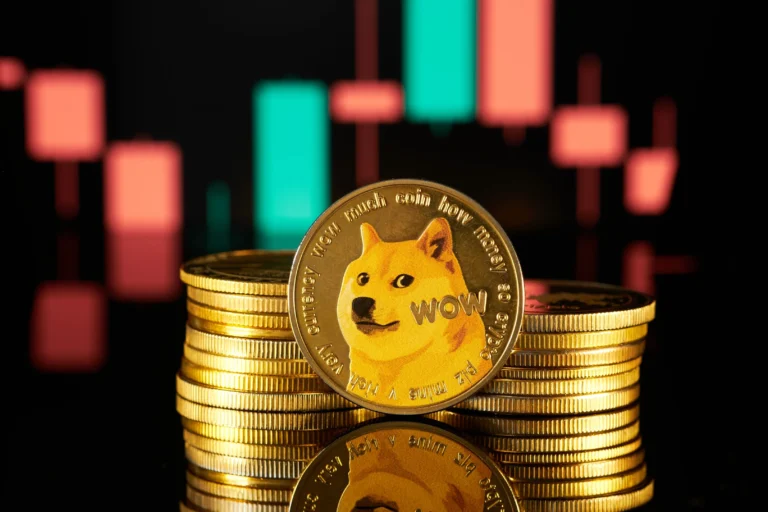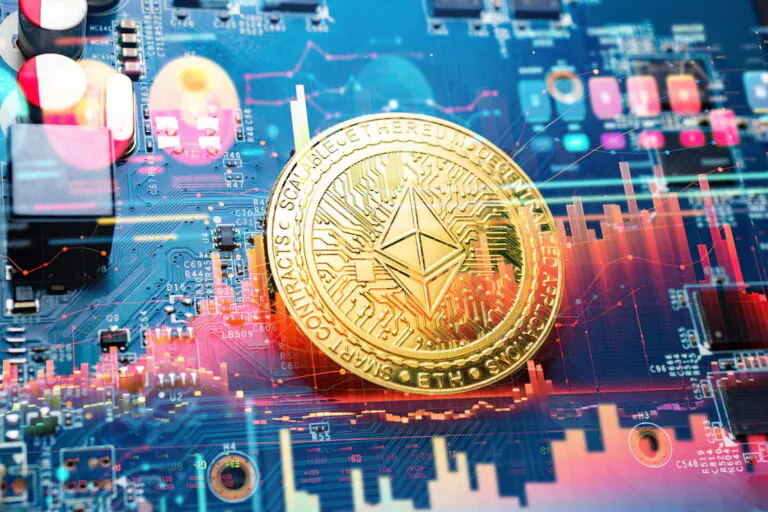Dogecoin (DOGE) with the image of a Shiba Inu dog called Kabosu as its logo, is one of the most popular and successful memecoins. It is considered an altcoin and was launched in December 2013.

VET cryptocurrency. How does VeChain help improve the business world?
What is VeChain?
VeChain is a blockchain that was created to simplify supply chain management. It was originally conceived as a way to determine the reality of a product (whether it exists or not) in order to prevent fraud and counterfeiting. Since then, large corporations have been using VeChain to track everything from wine production to car production.
This verification is quite simple: give each product a unique identity, and then use sensors to track what happens at each stage of the supply chain. In this way, companies can be sure that products are being handled correctly and consumers can be sure that their purchases are legal.
Who Invented VeChain? History of VeChain (VET)
VeChain was founded in 2015 by Sunny Lu, former Chief Information Officer (CIO) of Louis Vuitton China. He combined his expertise in luxury goods with blockchain technology to create an IoT (Internet of Things) application for supply chain management. He remains the CEO of VeChain through the VeChain Foundation, a non-profit organization.
Today, the VeChain team consists of more than 100 employees worldwide, offering blockchain as a service (BaaS) products to customers in the logistics and data management industries.
To date, VeChain has expanded its focus on multipurpose functionality with custom support for a range of enterprise use cases. On-chain governance, low transaction fees, non-blockchain compatibility, and compliance are all priorities for VeChain developers.
Features of VeChain
VeChain has many special features that distinguish VeChain from other blockchains and cryptocurrencies – these are its use cases for tracking goods and data. Companies that require a proven chain of ownership through manufacturing, shipping, or other processes can use VeChain for this purpose.
Using VeChain smart contracts in their activities, users can track ownership and control of any number of goods. For example, a manufacturer of electronic goods can track the distribution of products using VeChain. But the regulated marijuana industry can use VeChain to track seeds, plants, products sold, and sales for end-to-end compliance requirements.
The VeChain white paper suggests potential use cases for both the food and pharmaceutical industries. In both of these industries, it can be important to know if a product is safely received and held by different owners and facilities. VeChain is also useful for anti-counterfeiting, digital vehicle passports, or any open financial transactions.
VeChainThor can support new currencies and other smart contracts. The currencies on this blockchain follow the VIP180 standard developed specifically for VeChain, similar to the ERC-20 tokens on the Ethereum blockchain. This means that, unlike the power-hungry proof-of-work system used by Ethereum and Bitcoin, VeChain uses a proof-of-concept strategy to provide an efficient network that consumes relatively little power.
Advantages and disadvantages of VET
Focusing on scalable enterprise blockchain solutions, VeChain has some pros and cons.
Pluses:
- VeChain has established successful partnerships with global firms.
- The dual token system makes transaction costs more predictable.
- Focus on scalable and transparent business solutions.
- Provides the ability for end users to track and control their products.
Minuses:
- The PoA VeChain system may not be as effective as it seems.
- Higher cost to set up/run a node.
- Face stiff competition for their services.
How does VeChain work?
VeChain works by giving physical products a unique identification, usually through RFID (Radio Frequency Identification), QR codes or NFC (Near Field Communication). Sensors record information at every stage of the supply chain, record and link with product identification. These are sensors designed by VeChain and built by manufacturers such as Bosch and Qualcomm.
Because it uses blockchain technology, the recorded data cannot be changed. This allows you to keep a reliable record of what conditions were like throughout the supply chain. If something went wrong, such as goods being shipped to the wrong place, the blockchain entry will show exactly where the error occurred.
This also allows the recipient of the goods to verify that everything was done correctly and that the goods are genuine. This is particularly important in the fight against fraud in the luxury goods sector, such as expensive handbags. A small chip is placed in the bag, which, when scanned, reports on the processes through which it has passed on the way from production to delivery. This chip remains even after the bag is sold, allowing the owner to buy a used bag on eBay and still verify its authenticity.
VET Token
The VeChainThor blockchain, the public blockchain at the heart of VeChain, uses the VeChain Token (VET) and the VeThor Token (VTHO). The VeChain token is used to transfer value across the network, while the VeThor token is used as energy to power smart contract transactions.
VeChain originally issued tokens (known as VEN) on Ethereum before releasing its own platform in 2018. This new platform has been rebranded as VeChainThor (known as VET). VET is a payment used in the VeChain system. The more VET a person or enterprise has, the higher the priority when it comes to using blockchain resources.
Launch and initial distribution of tokens
The VeChain Foundation distributed the native token of its network to private, corporate and crowdsale investors back in 2017.
Initially, VeChain issued 1,000,000,000 VEN tokens, which equates to 100,000,000 VET. The initial distribution of VEN (which is the same percentage as VET) is as follows:
- 90,000,000 VEN (9,000,000,000 VET), 9% – to private investors;
- 230,000,000 VEN (23,000,000,000 VET), 23% – to corporate investors;
- 277,162,634 VEN (27,716,263,400 VET), 27.7% — bought by crowdsale investors;
- 132,837,366 VEN (13,283,736,600 VET), 13.3% – was burned by the VeChain Foundation as part of the token sale refund process;
- 50,000,000 VEN (5,000,000,000 VET), 5% – received by project team members;
- 220,000,000 VEN (22,000,000,000 VET), 22% – allocated by the fund for the costs of operating and developing the project.
Characteristics of the VET token (at the time of writing):
Rate: $0.02243
Market cap: $1,624,200,832
Trading volume (24 hours): $42,645,161
Maximum offer: 86,712,634,466 VET
Circulating supply: 72,510,000,000 VET
Mining VeChain (VET)
VeChain cannot be mined. Instead, it operates on a credential basis, where the largest participants act as network validators. This means that fewer computers are doing the work of verifying and operating the VeChain network. For individuals, this means that you are unlikely to be able to mine VeChain.
Those with a good reputation can be elected as validators by other members of the network. This is similar to proof-of-stake coins where those with the largest stake in the network choose validators. However, both use far less power than competing proof-of-work coins.
How to buy and where to store VeChain?
If you want to buy and own VeChain, you have several exchange and wallet options. As the top 35 cryptocurrencies by market capitalization, VeChain is widely supported and easy to buy on many major cryptocurrency exchanges such as Binance, KuCoin, Huobi, Bitfinex, Gate.io, Bittrex, Crypto.com and more. In addition, you can buy, sell or exchange VET for fiat or another cryptocurrency on the websites of online cryptocurrency exchangers, including our resource Coin24.io.
You can store the coin both on the official VeChain wallet and on other wallets, for example, the Ledger hardware wallet can be considered the most reliable.
VET price forecast from industry experts:
- Wallet Investor believes that the coin will have a long-term growth – by 2027 its price will be at the level of $0.318. With a five-year investment, the return will be approximately +594.32%.
- Digital Coin Price – by the end of 2025, the coin rate will be $0.0936.
- Trading Beasts says that by the end of 2024, the price of the coin will rise to $0.125.
- Long forecast expect the price of one VET token to be at $0.034 by the end of 2024.
- GOV Capital predicts a coin value of $0.73 until 2025.
The Future of the VeChain Platform
Now that VeChain is equipped with its own platform, has a solid track record of delivering on promises, and has secured desirable partnerships with major companies, there is no limit.
Announcements of their partnerships with BMW and Renault are expected in the future, and it is not known how many more companies under the PwC banner VeChain will attract.
The currency is largely seen as a good bet for investors because it has so many powerful partners in its name and real-world application.
Start your crypto exchange with Coin24

Exchange BTC, ETH, USDT and more — cash or card

Secure and fast crypto exchange since 2018



